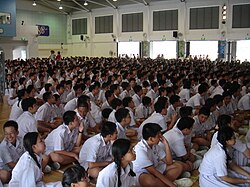This article has multiple issues. Please help improve it or discuss these issues on the talk page . (Learn how and when to remove these messages)
|


A school assembly is a gathering of all or part of a school for various purposes [1] , such as special programs or communicating information. [2] In some schools, students may to perform a common song or prayer, receive announcements, or present awards. A routine attendance check may be done in such gatherings. At some schools, these meetings may be substituted by smaller classroom gatherings (sometimes called form or home room ) and announcements broadcast over a public address system. Periodic school assemblies can be a forum for special presenters of educational, health, or safety materials, or for school plays, talent shows, etc.